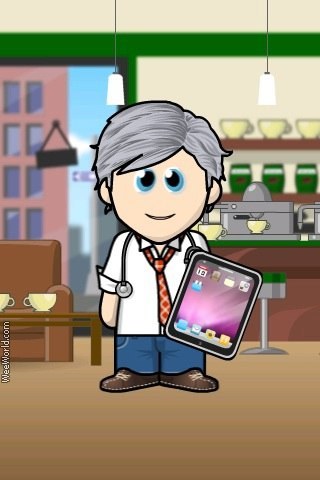Apr 16 2011
A Decent Cup of TeaI believe I can make a fairly good espresso, but it appears I am an epic fail at making tea.
Last night my guest Brendan rejected my Earl Grey effort as undrinkable.
I appreciate that making a decent cup of tea is very important, so today I called upon three eminent poms for advice.
Douglas Adams, George Orwell and John Lennon’s Aunt Mimi were all generous in replying.
Douglas Adams writes:
One or two Americans have asked me why it is that the English like tea so much, which never seems to them to be a very good drink. To understand, you have to know how to make it properly.
There is a very simple principle to the making of tea and it’s this – to get the proper flavour of tea, the water has to be boiling (not boiled) when it hits the tea leaves. If it’s merely hot then the tea will be insipid. That’s why we English have these odd rituals, such as warming the teapot first (so as not to cause the boiling water to cool down too fast as it hits the pot). And that’s why the American habit of bringing a teacup, a tea bag and a pot of hot water to the table is merely the perfect way of making a thin, pale, watery cup of tea that nobody in their right mind would want to drink. The Americans are all mystified about why the English make such a big thing out of tea because most Americans have never had a good cup of tea. That’s why they don’t understand. In fact the truth of the matter is that most English people don’t know how to make tea any more either, and most people drink cheap instant coffee instead, which is a pity, and gives Americans the impression that the English are just generally clueless about hot stimulants.
So the best advice I can give to an American arriving in England is this. Go to Marks and Spencer and buy a packet of Earl Grey tea. Go back to where you’re staying and boil a kettle of water. While it is coming to the boil, open the sealed packet and sniff. Careful – you may feel a bit dizzy, but this is in fact perfectly legal. When the kettle has boiled, pour a little of it into a tea pot, swirl it around and tip it out again. Put a couple (or three, depending on the size of the pot) of tea bags into the pot (If I was really trying to lead you into the paths of righteousness I would tell you to use free leaves rather than bags, but let’s just take this in easy stages). Bring the kettle back up to the boil, and then pour the boiling water as quickly as you can into the pot. Let it stand for two or three minutes, and then pour it into a cup. Some people will tell you that you shouldn’t have milk with Earl Grey, just a slice of lemon. Screw them. I like it with milk. If you think you will like it with milk then it’s probably best to put some milk into the bottom of the cup before you pour in the tea*. If you pour milk into a cup of hot tea you will scald the milk. If you think you will prefer it with a slice of lemon then, well, add a slice of lemon.
Drink it. After a few moments you will begin to think that the place you’ve come to isn’t maybe quite so strange and crazy after all.
* This is socially incorrect. The socially correct way of pouring tea is to put the milk in after the tea. Social correctness has traditionally had nothing whatever to do with reason, logic or physics. In fact, in England it is generally considered socially incorrect to know stuff or think about things. It’s worth bearing this in mind when visiting.
From the entry on Tea in h2g2– a website founded by Douglas Adam’s with the aim of being a real life version of the Hitchhikers Guide to the Galaxy. H2G2 is now run by BBC.
The h2g2 also has a rather annoying animation about the science behind putting the milk in the cup first.
George Orwell was a man of definite opinion. He has 11 golden rules for making tea.
If you look up ‘tea’ in the first cookery book that comes to hand you will probably find that it is unmentioned; or at most you will find a few lines of sketchy instructions which give no ruling on several of the most important points.
This is curious, not only because tea is one of the main stays of civilization in this country, as well as in Eire, Australia and New Zealand, but because the best manner of making it is the subject of violent disputes.
When I look through my own recipe for the perfect cup of tea, I find no fewer than eleven outstanding points. On perhaps two of them there would be pretty general agreement, but at least four others are acutely controversial.
Here are my own eleven rules, every one of which I regard as golden:
- First of all, one should use Indian or Ceylonese tea. China tea has virtues which are not to be despised nowadays — it is economical, and one can drink it without milk — but there is not much stimulation in it. One does not feel wiser, braver or more optimistic after drinking it. Anyone who has used that comforting phrase ‘a nice cup of tea’ invariably means Indian tea.
- Secondly, tea should be made in small quantities — that is, in a teapot. Tea out of an urn is always tasteless, while army tea, made in a cauldron, tastes of grease and whitewash. The teapot should be made of china or earthenware. Silver or Britanniaware teapots produce inferior tea and enamel pots are worse; though curiously enough a pewter teapot (a rarity nowadays) is not so bad.
- Thirdly, the pot should be warmed beforehand. This is better done by placing it on the hob than by the usual method of swilling it out with hot water.
- Fourthly, the tea should be strong. For a pot holding a quart, if you are going to fill it nearly to the brim, six heaped teaspoons would be about right. In a time of rationing, this is not an idea that can be realized on every day of the week, but I maintain that one strong cup of tea is better than twenty weak ones. All true tea lovers not only like their tea strong, but like it a little stronger with each year that passes — a fact which is recognized in the extra ration issued to old-age pensioners.
- Fifthly, the tea should be put straight into the pot. No strainers, muslin bags or other devices to imprison the tea. In some countries teapots are fitted with little dangling baskets under the spout to catch the stray leaves, which are supposed to be harmful. Actually one can swallow tea-leaves in considerable quantities without ill effect, and if the tea is not loose in the pot it never infuses properly.
- Sixthly, one should take the teapot to the kettle and not the other way about. The water should be actually boiling at the moment of impact, which means that one should keep it on the flame while one pours. Some people add that one should only use water that has been freshly brought to the boil, but I have never noticed that it makes any difference.
- Seventhly, after making the tea, one should stir it, or better, give the pot a good shake, afterwards allowing the leaves to settle.
- Eighthly, one should drink out of a good breakfast cup — that is, the cylindrical type of cup, not the flat, shallow type. The breakfast cup holds more, and with the other kind one’s tea is always half cold before one has well started on it.
- Ninthly, one should pour the cream off the milk before using it for tea. Milk that is too creamy always gives tea a sickly taste.
- Tenthly, one should pour tea into the cup first. This is one of the most controversial points of all; ind
eed in every family in Britain there are probably two schools of thought on the subject. The milk-first school can bring forward some fairly strong arguments, but I maintain that my own argument is unanswerable. This is that, by putting the tea in first and stirring as one pours, one can exactly regulate the amount of milk whereas one is liable to put in too much milk if one does it the other way round. - Lastly, tea — unless one is drinking it in the Russian style — should be drunk without sugar. I know very well that I am in a minority here. But still, how can you call yourself a true tealover if you destroy the flavour of your tea by putting sugar in it? It would be equally reasonable to put in pepper or salt. Tea is meant to be bitter, just as beer is meant to be bitter. If you sweeten it, you are no longer tasting the tea, you are merely tasting the sugar; you could make a very similar drink by dissolving sugar in plain hot water.
Some people would answer that they don’t like tea in itself, that they only drink it in order to be warmed and stimulated, and they need sugar to take the taste away. To those misguided people I would say: Try drinking tea without sugar for, say, a fortnight and it is very unlikely that you will ever want to ruin your tea by sweetening it again.
These are not the only controversial points to arise in connexion with tea drinking, but they are sufficient to show how subtilized the whole business has become. There is also the mysterious social etiquette surrounding the teapot (why is it considered vulgar to drink out of your saucer, for instance?) and much might be written about the subsidiary uses of tealeaves, such as telling fortunes, predicting the arrival of visitors, feeding rabbits, healing burns and sweeping the carpet. It is worth paying attention to such details as warming the pot and using water that is really boiling, so as to make quite sure of wringing out of one’s ration the twenty good, strong cups of that two ounces, properly handled, ought to represent.
First Published in the Evening Standard, 12th January 1946.
And finally, in a piece for the New York Times, Yoko Ono recalls a fond memory of ‘The Tea Maker’.
“Yoko, Yoko, you’re supposed to first put the tea bags in, and then the hot water.” John took the role of the tea maker, for being English. So I gave up doing it.
It was nice to be up in the middle of the night, when there was no sound in the house, and sip the tea John would make. One night, however, John said: “I was talking to Aunt Mimi this afternoon and she says you are supposed to put the hot water in first. Then the tea bag. I could swear she taught me to put the tea bag in first, but …”
“So all this time, we were doing it wrong?”
“Yeah …”
We both cracked up. That was in 1980. Neither of us knew that it was to be the last year of our life together.
If Brendan plays his cards right and ever gets a return bait to our house, I’ll be able to surprise him with a better cup of tea. My sources are impeccable.



 RSS - Posts
RSS - Posts


Leave a Reply